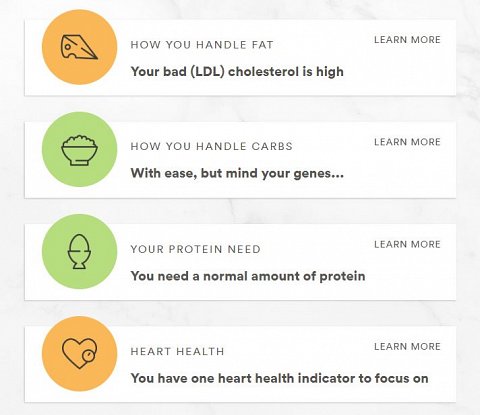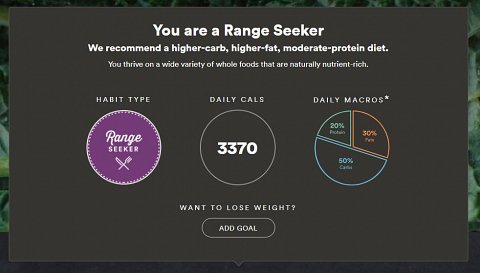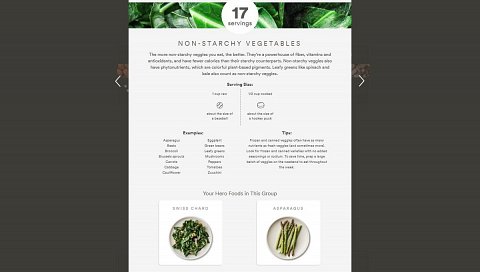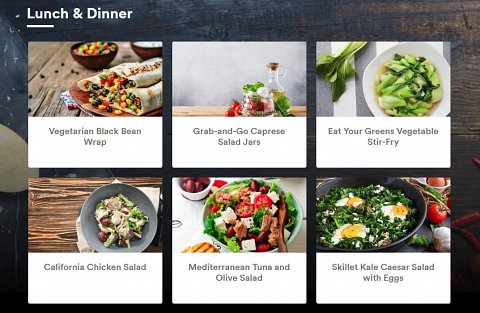-
Nutrition Test Kit
review on May 11, 2018
by Rebecca Fishwick

At a Glance
Summary
I was impressed by the sheer volume of information I received from Habit. Their findings and recommendations seemed well-researched, and references were provided for the different genes and indicators they’d analyzed to get my results. Though I was provided with a lot of nutritional information, it was not overwhelming, since I was told which foods were best for the different food groups and nutrients, and in which amounts, and so I was not left with a heap of nutritional information that only a trained professional could understand. Their recommendations were clear and actionable, and I felt they would be easy to incorporate into my life, so long as I was prepared to make the change.
Full Review
Habit is a personalized nutrition company based in Oakland, California. It was founded by Neil Grimmer, CEO, and Dr. Joshua Anthony, CSO. Grimmer previously founded Plum Organics, a company specializing in organic, high-quality baby food.
Habit uses at-home DNA collection kits combined with surveys to analyze genetics, lifestyle and metabolism together with personal goals in order to generate personalized eating recommendations.
Product Expectations
Going to the Habit website, I found it light, bright and polished. I saw that I would be able to take the Habit Nutrition Test at home and view my results online. I read that they took a “holistic” approach, and would look at my lifestyle, dietary preferences, physical activity, and my own goals as well as my DNA in order to create my personalized nutrition recommendations. At the bottom of the homepage, I found a list of media publications they had been mentioned in, and a note about Habit’s commitment to continue updating their results and recommendations as the science behind them improved.
Heading to the “How it Works” section, I found that I would be sending my sample to Aegis, a CLIA and CAP certified lab. There was also an app I could access, which would guide me through the process of collecting my sample. My results would be calculated using “decision tree logic” to create a biology report and eating plan. Once my results were ready, I would be able to access these on my web browser, or in the Habit app.
On the “Science” page, I learned that they would look at more than 60 indicators in my DNA to understand what my body needs. I also read that Habit were partnered with experts in systems biology and nutrition, to ensure that their recommendations are backed by scientific evidence.
I saw that in order to take the test, I would have to take a series of three blood samples, both before and after drinking ‘The Habit Challenge Shake’, which I read was the nutritional equivalent to “a large American breakfast”. The results would show how my body responds to carbs, fats, and protein.
There was also a breakdown of the different biomarkers they would look at, which included biomarkers for lactose and caffeine sensitivity, blood sugar, cholesterol, triglycerides, weight control, physical performance, heart health, and nutrient-related markers (looking at genes related to omega-3, vitamin D, and folate metabolism). They would also analyze self-reported markers, which included my age, sex, height, blood pressure, activity level and waist measurement.
At the bottom of the page was a list of their scientists and partners, and their scientific advisory board.
Browsing through the FAQs section, I found a video with instructions on taking the test. Watching it, I discovered that I would have to fast for 10 hours, and that it would take two and a half hours to take the test! I decided that I would definitely have to fast overnight, otherwise I would be passing out on the train…
Purchasing the kit, I had two options: ‘Habit Core’, or ‘Habit Ally’. Habit Core would include information about my DNA and metabolism, including how I handle macronutrients and “nutrition-related heart health markers”. I would also get personalized nutrition recommendations based on my test results.
Habit Ally included everything from Habit Core, plus four weeks of digital guidance and “tools to accelerate your adoption of new habits”. This included text messages offering motivation and support, a clean eating nutrition plan that could help you lose up to two pounds per week, personalized eating “strategies”, recipe and meal-planning tips, and progress tracking tools.
Additionally, if I already had my DNA tested by 23andMe or AncestryDNA, I could use those results, and save $100 on Habit Core (I could use previous results for Habit Ally too, but I wasn’t offered the $100 saving).
I was planning to buy Habit Core, and so I clicked on “See More” for further information.
Here, I saw much of the same information I had already read. But I learned that customers must be over 18 to purchase, and that services weren’t currently available to people who are pregnant, lactating or diabetic. The test kit would be delivered within 15 days of purchase, and I should allow six to eight weeks to receive my results after returning it. A prepaid, pre-labeled packet would be provided to return my sample.
I also read that more than 530 scientific references had been used to create the Habit recommendation system, and more than 11,000 hours had gone into designing the recommendation decision trees, and “ensuring they’re based on solid scientific evidence”.
Ordering Experience
Purchasing my kit, I had to enter my name and email, state (they didn’t ship to New York, New Jersey or Rhode Island), and birthdate, and check a few boxes about whether I had diabetes, whether I was allergic to dairy, if I was vegan and my gender. Then I had only to fill in my shipping and billing information, and accept the Terms and Conditions.
I had a look through the Terms and Conditions, and saw that my blood and saliva samples would be tested by a third-party laboratory. I also read that the Habit Challenge Shake was “designed to be a metabolic challenge”, and that there was a small risk it could lead to an upset stomach. They also recommended that if I felt ill during the testing process, I should discontinue immediately, and seek medical help if necessary.
I also read that I might receive diet recommendations for foods I am allergic or sensitive to, in which case, I shouldn’t follow them. Any recommendations I chose to follow would be at my own risk. I also learned that my information would be identified using a number in order to keep it confidential, and that Habit’s recommendations did not constitute medical advice.
Shortly after placing my order, I received a confirmation email. Eight days later, my kit arrived in the mail. The package was sleek, black and compact, and resembled that pictured on the website. I registered my kit online using the kit number and my email, and could follow the instructions on the website, or on the Habit iOS app.
Once I had confirmed my email, I had to enter my weight and waist measurement (a tape measure was provided).
I took the test the next day, after fasting for ten hours. Though I couldn’t eat during this time, I was told to make sure I stayed hydrated. When it came time to take the test, I followed the instructions online, which were straightforward and user-friendly. There were timers provided to make sure I followed each step at the right time, and for the right amount of time.
The test involved three cheek swabs, an initial blood test, and then two more blood tests after drinking the Habit Challenge Shake, which I’d put in the fridge. They had provided a lancet device for taking the blood samples. Though I felt apprehensive about pricking my finger (or three of my fingers!), the process was practically pain-free.
I also had to answer an online questionnaire, which included questions about my height, whether I had high blood pressure, my current activity levels, any dietary supplements I might take, and my food preferences.
To return the sample, I had been provided with a FedEx shipping envelope, which was prepaid and labeled with the address, so I had only to take it to my nearest dropbox.
Three days later, I received an email confirming that the lab had received my sample.
The Results
About five weeks after my sample reached the lab, I received an email telling me that my recipes for the week were ready. I was a bit confused, since I hadn’t received anything to say that my results were ready. Logging onto my account, I discovered they were.
After a brief tour, I was immediately taken to my results, which opened with a basic breakdown of my biological results (shown below).

A basic overview of my results.
As you can see, things that were fine were shown in green, whereas things I had to work on or be aware of were shown in orange. I don’t know if they might have been shown in red if they were really bad – luckily none of mine were.
There also were links to see my Nutrition Plan, and to see all of my biomarkers, which I could download and keep.
Results Section: My Biological Evaluation
Clicking on “How you handle fat”, I learned that although I didn’t have the genetic variant associated with a negative effect on blood fat (triglyceride), my bad cholesterol (LDL) was high. Still, my good cholesterol (HDL) was in the healthy range, as was my overall cholesterol level. I was told that there were recommendations in my Nutrition Plan that could help to lower my cholesterol.
There was also a breakdown of the indicators they had looked at in my blood sample in order to get these results (shown below).

A breakdown of my blood indicators.
While the information was rather technical, it was well presented, and it was reassuring to see the scientific evidence behind their findings.
Next, I went to “How you handle carbs”. Here, I found that although I have all the genetic variants that can negatively impact blood sugar levels, my blood test results showed that I was able to handle carbs well.
I could also see which genetic variants I had for the associated genes, and what impact my genotype might have on insulin production and blood sugar.
Looking through my other biological results, I discovered that I require a normal amount of protein, that I have a genetic variant associated with high blood pressure (though I reported my blood pressure as “normal”), that my weight was out of the ideal range (though my waist measurement was within it), that I wasn’t lactose intolerant (as I suspected), and that my body took longer to break down caffeine.
Results Section: My Nutrition Plan
Going to my Nutrition Plan, I was told that I am a “Range Seeker”. They recommended a “higher-carb, higher-fat, moderate-protein” diet, and said that I thrive on a variety of nutrient-rich whole foods (shown below).

My basic nutrition profile.
I saw that I could add a weight loss goal. Clicking this, I was shown my current weight and waist measurement (I could adjust these if they had changed since I’d taken them), and I could enter my goal weight. They would then adjust my recommended calorie intake and serving ratios as needed.
I was provided with my own “Food Philosophy”, which provided six general rules for my diet. These included making sure I ate a range of foods, watching out for hidden sugars, focusing on “lower fat sources” (such as dark meat poultry, flank steak or Greek yoghurt), making sure a third of my daily calories came from “quality dietary fat” (which can be found in nuts, plant-based oils or avocado), using carbs for my primary fuel, and incorporating vegetables into my meals and snacks to get more fiber.
Under this, I saw my “Food Groups”, which showed me how much of each food group I should eat in a day. I found I should have seventeen servings of fats, seven of fruits, ten of lean protein sources, and so on. I could click on each category for more information about the sorts of foods I should be eating, as well as portion sizes (shown below).

My daily serving recommendations for non-starchy vegetables.
I was also shown my “Hero Foods”, i.e., the foods that would provide me with the best nutrition for the different food groups. As you can see in the picture above, my Heroes for non-starchy vegetables were Swiss chard and asparagus. I’d never heard of Swiss chard before (which made me feel a little uncultured!), but I’m a fan of asparagus, so I welcomed that recommendation.
There were also recommendations for my daily nutrient intake, again tailored for me. Clicking on each vitamin or mineral told me what my body needed it for, and which foods I could find it in. It occurred to me that if I found it hard to incorporate all these nutrients into my daily diet, I could use this list as a guide for what supplements to buy, and in what dosage.
Results Section: My Weekly Recipes
My weekly recipes contained a total of nine meal recommendations per week: three breakfast recipes, and six lunch and dinner recipes. I wouldn’t be told what to eat for every meal of every day, and there were no snack suggestions. But I would be able to incorporate these meals into my weekly routine, and gradually accumulate recipes over the weeks. Had I opted for Habit Ally, I would have had a full nutrition plan – though only for four weeks.
There were pictures of each meal they recommended, which all looked bright and colorful and – most importantly – healthy (shown below).

My lunch and dinner recommendations.
Apart from the vegetable stir-fry (which looked rather plain), I thought the meals all looked tasty as well. Clicking on each one, I was taken to an ingredients list and cooking instructions. There was a breakdown of the protein, carbohydrate, and fat ratios, what percentage of my daily calorie intake and nutrient recommendations the meal constituted, which food preferences it accommodated, and how many portions would be produced. There was also an option to print the recipe.
Results Section: My Profile and Account Settings
Going to my “Profile”, I found I could adjust my core waist measurement and weight, edit my questionnaire answers (including food preferences), connect a Fitbit account (which could adjust my nutrition recommendations based on my activity and weight), and edit my activity level (or sync this information from a Fitbit device).
In “Account Settings”, I could edit my name, email, and phone number, or change my password. There was also an “Order History” page, showing me when I’d placed my order.
Summary
I was impressed by the sheer volume of information I received from Habit. Their findings and recommendations seemed well-researched, and references were provided for the different genes and indicators they’d analyzed to get my results. Though I was provided with a lot of nutritional information, it was not overwhelming, since I was told which foods were best for the different food groups and nutrients, and in which amounts, and so I was not left with a heap of nutritional information that only a trained professional could understand. Their recommendations were clear and actionable, and I felt they would be easy to incorporate into my life, so long as I was prepared to make the change.


